This article needs additional citations for verification .(July 2020) |
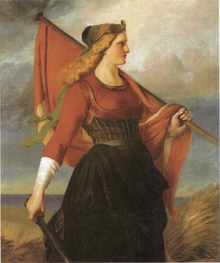
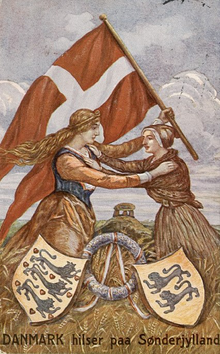
Mother Denmark (Danish: Moder Danmark) is the female personification of Denmark and a patriotic emblem of the Danish nation.
This article needs additional citations for verification .(July 2020) |


Mother Denmark (Danish: Moder Danmark) is the female personification of Denmark and a patriotic emblem of the Danish nation.
Allegorial representations of Denmark as a woman with antique garments and a coat of arms are first seen in the 18th century. In the 19th century, with Romantic Nationalism, it became more common. Writers such as N.F.S. Grundtvig, B. S. Ingemann and Steen Steensen Blicher have all used Mother Denmark as a national symbol of Denmark and a manifestation of national emotions. [1]
In 1851, under influence of the Danish victory in the Battle of Isted, Elisabeth Jerichau Baumann created a painting of Mother Denmark in the form of a young woman, with a Dannebrog and Viking jewellery, holding an antique sword, walking through a field. The painting became a model for many later depictions of Mother Denmark. [1]
In the second half of the 20th century, Mother Denmark references grew out of fashion. They have since then mainly been used in caricature drawing. [2]

Many monuments and memorials that commemorate the 1920 Reunification Sønderjylland with Denmark incorporate a Mother Denmark figure, typically accompanied by a daughter, representing Sønderjylland. An example is the Reunification Memorial at the main entrance to Fælledparken in Copenhagen. [3]
A statue of Mother Denmark is also seen in the Danish Emigrants Memorial in Copenhagen. [4]
The sculptor Arne Bang has also created a Mother Denmark sculpture. A bronze cast of it is located in Fensmark.

Albert Bertel Thorvaldsen was a Danish sculptor and medalist of international fame, who spent most of his life (1797–1838) in Italy. Thorvaldsen was born in Copenhagen into a working-class Danish/Icelandic family, and was accepted to the Royal Danish Academy of Art at the age of eleven. Working part-time with his father, who was a wood carver, Thorvaldsen won many honors and medals at the academy. He was awarded a stipend to travel to Rome and continue his education.
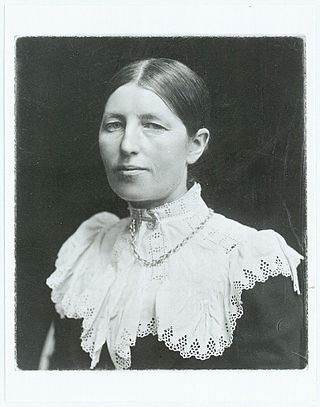
Anna Ancher was a Danish artist associated with the Skagen Painters, an artist colony on the northern point of Jylland, Denmark. She is considered to be one of Denmark's greatest visual artists.

Johannes Wiedewelt, Danish neoclassical sculptor. He became a court sculptor, introducing neoclassical ideals to Denmark in the form of palace decorations, garden sculptures and artifacts and, especially, memorial monuments. He was undoubtedly the best known Danish sculptor before Bertel Thorvaldsen.
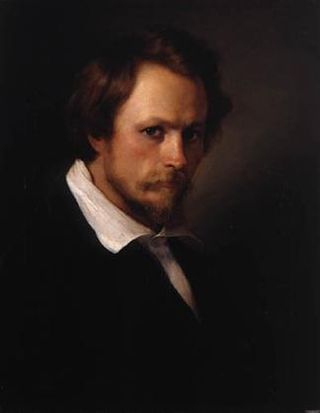
Emil Jens Baumann Adolf Jerichau was a Danish sculptor. He belonged to the generation immediately after Bertel Thorvaldsen, for whom he worked briefly in Rome, but gradually moved away from the static Neoclassicism he inherited from him and towards a more dynamic and realistic style. He was a professor at the Royal Danish Academy of Fine Arts and its director from 1857 to 1863.

Aksel (Axel) Einar (Ejnar) Utzon-Frank was a Danish sculptor and professor at the Royal Danish Academy of Fine Arts. During his lifetime, he produced many sculptures, some of which stand as public monuments. Utzon-Frank was son of Jens Christian Frank and Anna Cathrine Utzon. Anna Cathrine was sister to the grandfather of Pritzker Prize-winning architect Jørn Utzon.
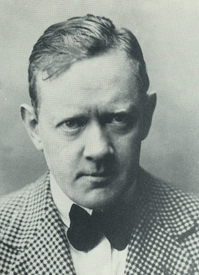
Kai Nielsen was a Danish sculptor.
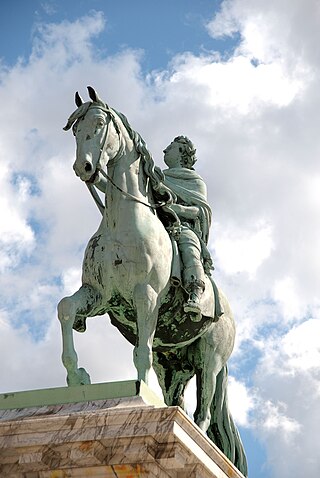
Danish sculpture as a nationally recognized art form can be traced back to 1752 when Jacques Saly was commissioned to execute a statue of King Frederick V of Denmark on horseback. While Bertel Thorvaldsen was undoubtedly the country's most prominent contributor, many other players have produced fine work, especially in the areas of Neoclassicism, Realism, and in Historicism, the latter resulting from growing consciousness of a national identity. More recently, Danish sculpture has been inspired by European trends, especially those from Paris, including Surrealism and Modernism.

Svend Rathsack was a Danish sculptor.
Adam Fischer was a Danish sculptor, an early contributor of works inspired by Cubism.

Suzette Catherine Holten was a Danish painter and ceramist who belonged to the Skovgaard family of artists. In addition to landscapes, flower paintings and portraits, she created and decorated ceramics and also worked as an embroiderer. As a woman, she was unable to achieve the same level of acclaim as her father or brothers.
Olivia Holm-Møller (1875–1970) was a Danish painter and sculptor. Her richly coloured, almost abstract paintings provide a bridge between the early Danish Modernism of the 1910s and the Cobra works of the 1950s.
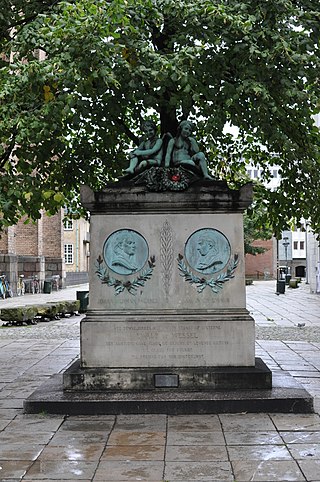
The Johannes Ewald and Johan Hermann Wessel Memorial is located next to the Round Tower and Trinitatis Church, just off Købmagergade, in central Copenhagen, Denmark. Johannes Ewald and Johan Herman Wessel were two of the leading Danish poets of the 18th century.

The Reunification Monument marks the main entrance to Fælled Park from Trianglen in the Østerbro district of Copenhagen, Denmark. It was created by the artist Axel Poulsen, in collaboration with the architect Holger Jacobsen, to commemorate the reunification of Sønderjylland with Denmark in 1920.
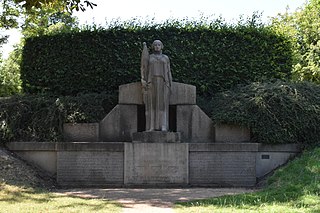
The Memorial to Nordic Volunteers and Fallen, located on Smedelinien, part of Kastellet, is a memorial to 28 Norwegian, Swedish and Finnish volunteers of the First (1848–50) and Second Schleswig War (1864). It was inaugurated in 1920 to design by Anders Bundgaard.
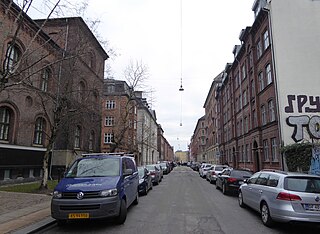
Prinsesse Charlottes Gade is a street in the Nørrebro district of Copenhagen, Denmark, linking Meinungsgade in the southeast with Jagtvej in the northwest.
Hanne Varming née Larsen was a Danish sculptor and medallist. Her works include statues of celebrities such as Victor Borge but generally depict ordinary people or even her own children. Her portraits of Queen Margrethe II can be seen on the Danish 10 and 20 crown pieces. Her representation of an old couple sitting on a bench in Copenhagen's Kultorvet is inspired by Hans Christian Andersen's Hyldemoer or The Little Elder-Tree Mother.

Siegfried Wagner was a Danish sculptor.
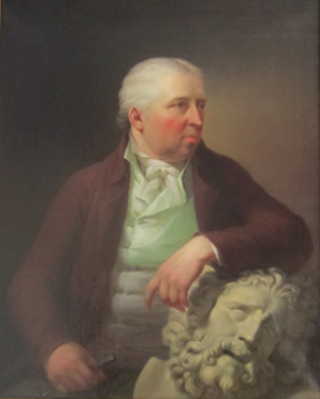
Nicolai Dajon was a Danish sculptor. He served as director of the Royal Danish Academy of Fine Arts from 1818 to 1821.

The Statue of Asmus Jacob Carstens is a statue of German-Danish painter Asmus Jacob Carstens situated in the garden of the Ny Carlsberg Glyptotek, facing Niels Brocks Gade, in Copenhagen, Denmark. It was created by Theobald Stein in 1878–1879 and moved to its current location in 1894. It is complemented by a statue of Georg Zoëga facing Tietgensgade on the other side of the museum. The monument is flanked by two other bronze statues, Jules Dalou's Field Worker (1893) and Constantin Meunier's The Hammerman.

HDMS Thetis was a frigate of the Royal Danish Navy, which she served from 1842 to 1864. She is best known for being one of the ships that picked up some of the sculptor Bertel Thorvaldsen's artworks and other belongings in Rome, some forty years after another Danish naval vessel by the same name had transported him the other way. In the meantime he had achieved international fame for his Neoclassical sculptures. Thorvaldsen, who had been back in Rome since September 1841, after moving back to Copenhagen in 1838, was also supposed to return with the ship. He did however, miss its departure by one day. The Royal Danish Navy's first music corps played its first performance on board the Thetis in 1857.